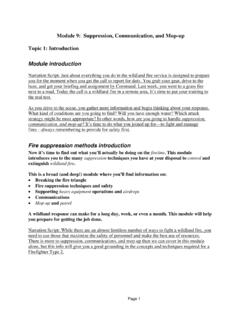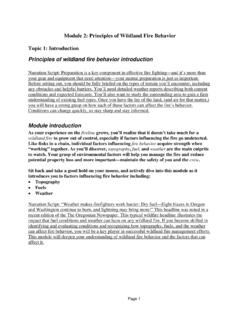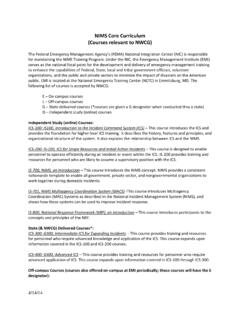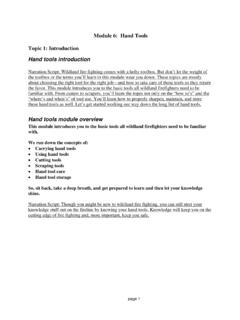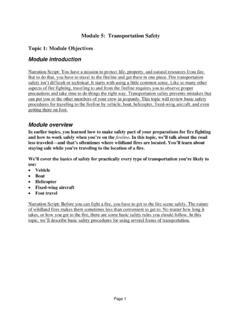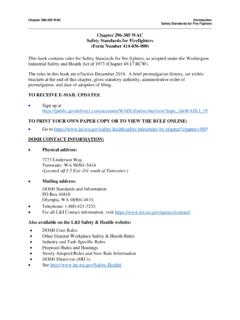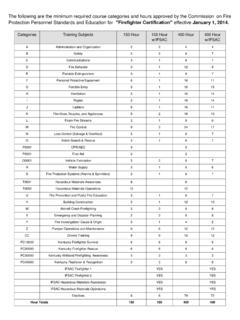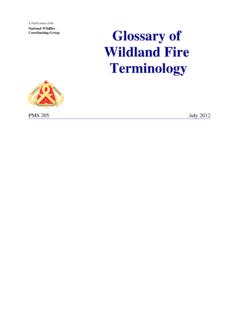Transcription of Module 1: Basic Concepts of Wildland Fire Topic 1: Course ...
1 Page 1 Module 1: Basic Concepts of Wildland fire Topic 1: Course Introduction Wildland fire behavior Course introduction During the heat of summer, avoiding news reports of a Wildland fire raging somewhere across the country is nearly impossible. Wildland fire is often thought of as something that happens deep in national forests, out in rangelands, or perhaps in crop fields. Unfortunately, the truth is that Wildland fires also occur in areas adjacent to residential and commercial development, such as: Vacant lots Parks Golf courses Highway medians When this happens, you are facing an increasingly common scenario a Wildland /urban interface fire .
2 In either case, you need to understand the basics behind fire behavior in order to begin to anticipate how tactics and safety procedures change according to the conditions at hand. Narration Script: Welcome to the Introduction to Wildland fire Behavior Course S-190. You re probably here to acquire skills to move toward your goal of becoming a certified Wildland firefighter. This will take dedication, knowledge, and skill on your part, and this Course will be part of your preparation. Every fire season seems to set yet another record for number of acres burned and the amount of money spent to fight Wildland fires. A recent fire season was double the 10-year average of prior fire seasons and with temperatures trending upward, there s sure to be more Wildland fires in our future.
3 As you ll soon discover, mental preparation is as much a part of Wildland fire fighting as your physical conditioning so let s get started. Course objectives The Course objectives are simple enough to describe however, attaining these goals will require the professionalism and determination required of all Wildland firefighters . By the end of this Course , you should be able to: Identify and discuss the three sides of the fire triangle Identify the environmental factors of fuels, weather, and topography affecting the start and spread of Wildland fire Page 2 Describe the contributing factors indicating potential for increased fire behavior that might compromise your safety This Course provides the foundation to understanding the characteristics and interactions of the Wildland fire environment and how those factors influence a fire s behavior.
4 Ultimately, your safety is the top priority. Narration Script: On the fireline, you ll need your powers of observation to maintain your safety and that of your fellow crew members. This Course is designed to give you the foundational knowledge you ll need to follow one of the golden rules of Wildland fire fighting: look up, look down, and look around. Experienced firefighters know that observation, evaluation, and anticipation are your friends when managing a fire make sure to study up and make them yours as well. Course overview There s a good chance this is your first formal Wildland fire behavior training so we ll give you the basics . The modules you will be working through are: Basic Concepts of Wildland fire introducing Wildland fire terminology, the fire triangle, and heat transfer methods Principles of Wildland fire Behavior describing fuels and their relation to the rate of spread (ROS) as well as weather and topography impacts Wildland fire Behavior and Safety discussing the differences between problem and extreme fire behavior and emphasizing the must-follow rules described in the Incident Response Pocket Guide (IRPG) After each Module , there will be a Challenge Review where you ll show you ve picked up the required knowledge, so be sure to take your time and feel free to review the material as much as you d like.
5 Narration Script: The purpose of this Course is to help novice firefighters or anyone tasked with Wildland fire fighting duties safely perform fire suppression and management duties in a Wildland environment and obtain their Firefighter Type 2 certification. If you re under the impression that fire fighting is a literal walk in the park or a nice job to perform in the great outdoors realize now that you ll need to spend as much time training your mind as you will your body. If you re new to Type 2 skill sets and responsibilities or if you come from a structural fire fighting background and tend to fall back on that mind-set, you re going to need to rethink a few things and maybe learn from scratch about Wildland fire behavior terminology, fuels, weather and topography, safety, observation, and following the by-the-book procedures designed to maintain your safety.
6 Page 3 Course prerequisites There are no prerequisites to the S-190 Introduction to Wildland fire Behavior Course but completing the Course won t necessarily ensure you are ready to hit the fireline immediately. Your local agency determines the requirements for each fire fighting position. These are all established by your local authority having jurisdiction and may include: Minimum educational requirements Minimum age requirements Local medical requirements Local physical requirements So, be sure to get the basics here and then consult with your local agency.
7 Good luck and good learning! Narration Script: Completing the S-190 Introduction to Wildland fire Behavior Course is one step toward getting your Firefighter Type 2 certification, but it doesn t necessarily ensure you ll be able to fight fires. For instance, some local agencies are concerned that you ve got the educational background, the stamina to pass some physical challenges, and that you re at least 18. Like structural fire fighting, Wildland fire fighting is a hazardous, physically demanding activity that requires good decision-making skills. So, be sure to consult with your local agency and make sure you have all your t s crossed and the i s dotted before applying for a position. Topic conclusion That concludes the Course Introduction Topic .
8 You should now have a good idea of: Why you are here What we expect you to get out of the Course How the Course is organized Narration Script: You should now have a good idea of where we re going with this Course . Page 4 Topic 2: fire Behavior Topic introduction Welcome to the world of Wildland fire fighting. You re probably anxious to get started fighting Wildland fires, but before you do, you need to have a firm grasp of many key Concepts .
9 As the saying goes, Rome wasn t built in a day and you won t be prepared to fight Wildland fires in a day either. So let us help you build a strong foundation of knowledge to stand on before you head out to the heat of the fireline. This first Topic covers these basics of Wildland fire fighting: Wildland fire fighting terminology fire triangle Heat transfer Breaking the fire triangle Narration Script: Before you head for the field, you need to know the basics . Even the most experienced of Wildland firefighters will turn to their trusty Incident Response Pocket Guides (IRPGs) and Fireline Handbooks to refresh themselves on the all-so-important basics . In this Topic , we ll help you begin building the knowledge base you ll need to fight Wildland fires safely and effectively.
10 Parts of a Wildland fire Part of talking the talk is having a diverse Wildland fire fighting vocabulary. All firefighters working on Wildland fires will use certain terms, and you need to be in the know. In this section, you ll learn about the parts of a Wildland fire . These parts are named for their unique characteristics and locations. Some of the most common names you ll hear associated with the main fire are: Origin Head Fingers Pocket Perimeter Rear Flanks Islands Read about each term to learn the lingo. Page 5 Origin The origin is the area where the fire started.
